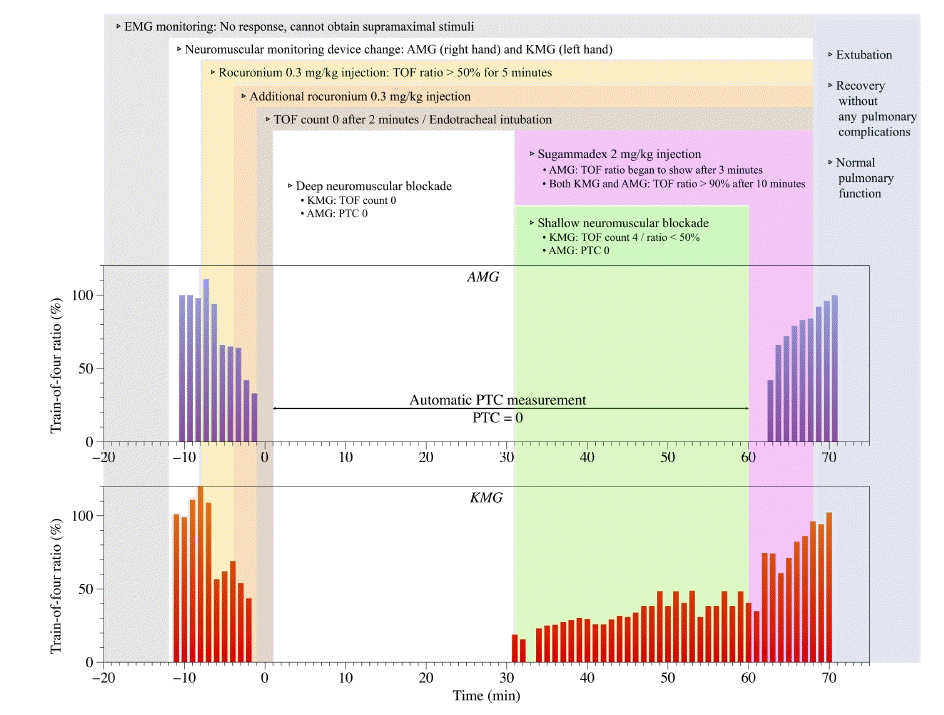1. Kwak HJ, Han SM, Kim DY, Kwak HS. Anesthetic management for a patient with Charcot-Marie-Tooth disease using propofol and rocuronium. Korean J Anesthesiol. 2003; 44:721–4.

2. Nam SH, Choi BO. Clinical and genetic aspects of Charcot-Marie-Tooth disease subtypes. Precis Future Med. 2019; 3:43–68.

3. Lee JH, Choi BO. Charcot-marie-tooth disease: seventeen causative genes. J Clin Neurol. 2006; 2:92–106.

4. Barreto LC, Oliveira FS, Nunes PS, de Franca Costa IM, Garcez CA, Goes GM, et al. Epidemiologic study of Charcot-Marie-Tooth disease: a systematic review. Neuroepidemiology. 2016; 46:157–65.

5. Park HJ, Choi YC, Oh JW, Yi SW. Prevalence, mortality, and cause of death in Charcot-Marie-Tooth disease in Korea: a nationwide, population-based study. Neuroepidemiology. 2020; 54:313–9.

6. Koros C, Evangelopoulos ME, Kilidireas C, Andreadou E. Central nervous system demyelination in a Charcot-Marie-Tooth type 1A patient. Case Rep Neurol Med. 2013; 2013:243652.

7. Hattori N, Yamamoto M, Yoshihara T, Koike H, Nakagawa M, Yoshikawa H, et al. Demyelinating and axonal features of Charcot-Marie-Tooth disease with mutations of myelin-related proteins (PMP22, MPZ and Cx32): a clinicopathological study of 205 Japanese patients. Brain. 2003; 126:134–51.

8. Aboussouan LS, Lewis RA, Shy ME. Disorders of pulmonary function, sleep, and the upper airway in Charcot-Marie-Tooth disease. Lung. 2007; 185:1–7.

9. Kurihara S, Adachi Y, Wada K, Awaki E, Harada H, Nakashima K. An epidemiological genetic study of Charcot-Marie-Tooth disease in Western Japan. Neuroepidemiology. 2002; 21:246–50.

10. Hiramatsu S, Moriwaki K, Nakao M, Tsutsumi YM. Rocuronium-induced respiratory paralysis refractory to sugammadex in Charcot-Marie-Tooth disease. Can J Anaesth. 2022; 69:364–8.

11. Naoki I, Hiroshi H, Risa T, China N, Yoshinori I, Hiroshi N, et al. Use of sugammadex in a patient with Charcot-Marie-Tooth disease under general anesthesia. Use of sugammadex in a patient with Charcot-Marie-Tooth disease under general anesthesia. Stomatological Disease and Science. 2018; 2:2.
12. Pogson D, Telfer J, Wimbush S. Prolonged vecuronium neuromuscular blockade associated with Charcot Marie Tooth neuropathy. Br J Anaesth. 2000; 85:914–7.

13. Cheong YK, Lee C, Son Y, Song YK, Kim TY, Kim DJ, et al. Delayed recovery of neuromuscular blockade by rocuronium in a patient with Charcot-Marie-Tooth disease: case reports. Korean J Anesthesiol. 2007; 53:145–9.

14. Antognini JF. Anaesthesia for Charcot-Marie-Tooth disease: a review of 86 cases. Can J Anaesth. 1992; 39:398–400.

15. Baraka AS. Vecuronium neuromuscular block in a patient with Charcot-Marie-Tooth syndrome. Anesth Analg. 1997; 84:927–8.

16. Garcia-Ferreira J, Hernandez-Palazon J. Response to cisatracurium in patient with Charcot-Marie-Tooth disease. Eur J Anaesthesiol. 2005; 22:160–1.

17. Goto T, Hurford WE. Postoperative acute respiratory failure following thoracotomy in a patient with Charcot-Marie-Tooth disease. J Clin Anesth. 1994; 6:434–6.
18. Fuchs-Buder T, Claudius C, Skovgaard LT, Eriksson LI, Mirakhur RK, Viby-Mogensen J; 8th International Neuromuscular Meeting. Good clinical research practice in pharmacodynamic studies of neuromuscular blocking agents II: the Stockholm revision. Acta Anaesthesiol Scand. 2007; 51:789–808.

19. Vilaça MJL, Coelho FM, Faísco A, Carmona C. [Anesthetic considerations for a patient with hereditary angioedema - A clinical case]. Rev Bras Anestesiol. 2017; 67:541–3. Portuguese.

20. Naguib M, Flood P, McArdle JJ, Brenner HR. Advances in neurobiology of the neuromuscular junction: implications for the anesthesiologist. Anesthesiology. 2002; 96:202–31.
21. Jung KT, An TH. Updated review of resistance to neuromuscular blocking agents. Anesth Pain Med. 2018; 13:122–7.

22. Lee W. The latest trend in neuromuscular monitoring: return of the electromyography. Anesth Pain Med. 2021; 16:133–7.

23. Chung T, Prasad K, Lloyd TE. Peripheral neuropathy: clinical and electrophysiological considerations. Neuroimaging Clin N Am. 2014; 24:49–65.
24. Nodera H, Bostock H, Kuwabara S, Sakamoto T, Asanuma K, Jia-Ying S, et al. Nerve excitability properties in Charcot-Marie-Tooth disease type 1A. Brain. 2004; 127:203–11.

25. Schmitt HJ, Münster T. Mivacurium-induced neuromuscular block in adult patients suffering from Charcot-Marie-Tooth disease. Can J Anaesth. 2006; 53:984–8.

26. Gálvez-Cañellas JL, Errando CL, Martínez-Torrente F, Mayor F, Zasadowski M, Villanueva Y, et al. Anaesthesia and orphan disease: difficult monitoring of neuromuscular blockade in a patient with severe Charcot-Marie-Tooth disease type I. Eur J Anaesthesiol. 2013; 30:772–5.
27. Scurry AN, Heredia DJ, Feng CY, Gephart GB, Hennig GW, Gould TW. Structural and functional abnormalities of the neuromuscular junction in the Trembler-J homozygote mouse model of congenital hypomyelinating neuropathy. J Neuropathol Exp Neurol. 2016; 75:334–46.

28. Kim YB, Sung TY, Yang HS. Factors that affect the onset of action of non-depolarizing neuromuscular blocking agents. Korean J Anesthesiol. 2017; 70:500–10.

29. Pasha TM, Knowles A. Anaesthetic management of a patient with Charcot-Marie-Tooth disease for staged diaphragmatic plication. Br J Anaesth. 2013; 110:1061–3.

30. Naguib M, Brull SJ, Johnson KB. Conceptual and technical insights into the basis of neuromuscular monitoring. Anaesthesia. 2017; 72 Suppl 1:16–37.

31. Oh SK, Park S, Lim BG, Kim YS, Kim H, Kong MH. Comparison between the trapezius and adductor pollicis muscles as an acceleromyography monitoring site for moderate neuromuscular blockade during lumbar surgery. Sci Rep. 2021; 11:14568.

32. Kim JW, Kim G, Kim TW, Han W, Maeng JH, Jeong CY, et al. Anesthesia in a patient with Charcot-Marie-Tooth disease with pneumothorax: a case report. J Int Med Res. 2019; 47:5896–902.

33. Kapoor H, Shah M, Desai S. Anaesthetic implications in patient with Charcot-Marie-Tooth disease. Indian J Anaesth. 2021; 65:561–2.

34. Naguib M, Samarkandi AH. Response to atracurium and mivacurium in a patient with Charcot-Marie-Tooth disease. Can J Anaesth. 1998; 45:56–9.

35. Schmitt HJ, Wick S, Münster T. Onset and duration of mivacurium-induced neuromuscular blockade in children with Charcot-Marie-Tooth disease. A case series with five children. Paediatr Anaesth. 2006; 16:182–7.





 PDF
PDF Citation
Citation Print
Print





 XML Download
XML Download